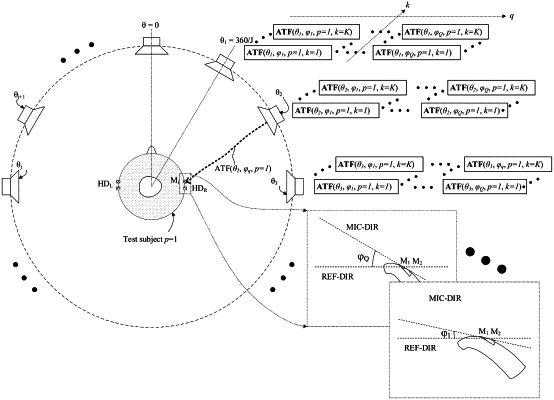| CPC H04R 25/407 (2013.01) [G06N 20/00 (2019.01); H04R 25/405 (2013.01); H04R 25/505 (2013.01); G06F 16/61 (2019.01); H04R 2225/51 (2013.01)] | 20 Claims |

|
1. A hearing aid system comprising a hearing aid configured to be worn on a head at an ear or in the ear of a user, the hearing aid comprising:
a microphone system comprising a multitude of M of microphones arranged in said hearing aid, where M is larger than or equal to two, the microphone system being adapted for picking up sound from an environment and to provide M corresponding electric input signals xm(n), m=1, . . . , M, n representing time, the environment sound at a given microphone comprising a mixture of
a target sound signal sm(n) propagated via an acoustic propagation channel from a direction to or a location (θ) of a target sound source to the mth microphone of the hearing aid when worn by the user, and
possible additive noise signals vm(n) as present at a location of the mth microphone, wherein the acoustic propagation channel is modeled as xm(n)=sm(n)hm(θ)+vm(n), and wherein hm(θ) is an acoustic impulse response for sound for the acoustic propagation channel;
the hearing aid system comprising:
a processor connected to said multitude of microphones, and
a database Θ comprising a multitude of dictionaries Δp, p=1, . . . , P, where p is a person index, of vectors, termed ATF-vectors, whose elements ATFm, m=1, . . . , M, are frequency dependent acoustic transfer functions representing direction- or location-dependent (θ), and frequency dependent (k) propagation of sound from the direction or location (θ) of a target sound source to each of said M microphones, k being a frequency index, k=1, . . . , K, where K is a number of frequency bands, when said microphone system is mounted on a head at an ear or in the ear of a natural or artificial person (p), and wherein each of said dictionaries Δp comprises ATF-vectors for a given person (p) for a multitude of different directions or locations θj, j=1, . . . , J, relative to the microphone system; and
wherein the processor is configured to, at least in a learning mode of operation, determine personalized ATF-vectors (ATF*) for said user based on said multitude of dictionaries Δp of said database Θ, said electric input signals xm(n), m=1, . . . , M, and said model of the acoustic propagation channels.
|
|
20. A method of operating a hearing aid system comprising a hearing aid configured to be worn on a head at an ear or in the ear of a user is provided, the method comprising:
providing by a multitude of microphones a corresponding multitude of electric input signals xm(n), m=1, . . . , M, n representing time, comprising environment sound from an environment of the user, wherein the environment sound of a given one of said multitude of electric input signals comprises a mixture of
a target sound signal sm(n) propagated via an acoustic propagation channel from a direction to or a location (θ) of a target sound source to the mth microphone of the hearing aid when worn by the user, and
possible additive noise signals vm(n) as present at a location of the mth microphone, wherein the acoustic propagation channel is modeled as xm (n)=sm(n)hm(θ)+vm(n), and wherein hm(θ) is an acoustic impulse response for sound for that acoustic propagation channel,
providing, or providing access to, a database Θ comprising a dictionary Δp of vectors, termed ATF-vectors, whose elements ATFm(θ,p,k), m=1, . . . , M, are frequency dependent acoustic transfer functions representing direction- or location-dependent (θ), and frequency dependent (k) propagation of sound from the location (θ) of a target sound source to each of said M microphones, k being a frequency index, k=1, . . . , K, where K is a number of frequency bands, when said microphone system is mounted on a head at an ear or in the ear of a natural or artificial person (p), and wherein said dictionary Δp comprises ATF-vectors ATF for said person (p) for a multitude of different directions or locations θj, j=1, . . . , J relative to the microphone system;
providing that the database Θ comprises a multitude P of dictionaries Δp, p=1, . . . , P, where p is a person index, said dictionaries comprising ATF-vectors ATF for a corresponding multitude of different natural or artificial persons (p); and
processing, at least in a learning mode of operation, said multitude of dictionaries Δp of said database Θ, said electric input signals xm(n), m=1, . . . , M, and said model of the acoustic propagation channels to thereby determine personalized ATF-vectors ATF* for said user.
|